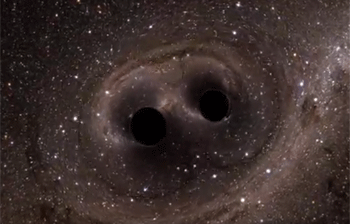Jul 18 2016
An international team of scientists has today (Wednesday 16 June 2016) announced a belated Christmas present for the world of astronomy as it confirms the detection, on Boxing Day 2015, of gravitational waves from a second instance of two black holes colliding. This latest finding opens the door on a new age of astronomy.
 (Credit:University of Sheffield)
(Credit:University of Sheffield)
The new observation, from a global team that involves many researchers from the UK, including the University of Sheffield, is of two black holes orbiting each other over 25 times before merging into a more massive spinning single black hole 21 times the mass of the sun.
Unlike the discovery first gravitational waves observation detected in September 2015, in the "Boxing Day" binary at least one of the black holes is spinning.
This new observation suggests there is a rich population of binary black holes in the Universe, whose properties are gradually starting to emerge. Gravitational-wave astronomy is no longer a field of single detections, but of regular observations. This latest discovery transforms the LIGO detector into a true astronomical observatory.
Dr Ed Daw from the University of Sheffield’s Department of Physics and Astronomy, who has been researching gravitational waves with LIGO since 1998, said: “The detection of the collision of one pair of black holes was amazing; the detection of a second one is spectacular, because it hints that there are lots more of these things out there.
“But it also raises more questions - what made these black holes? How many of these things are there? Can we start to really test general relativity in detail? Can we make LIGO work at even higher sensitivity so that we can detect tens or hundreds more of these events, and start to see other event populations such as neutron star binaries?
“Sheffield continues to work with LIGO and we should see many, many more exciting astronomical events that will turn the field on its head. It's a great time to be involved in this science, and we can't wait to see what's in store during the second observing run.”
Scientists observed gravitational waves—ripples in the fabric of spacetime—for the second time on 26 December 2015 at precisely 03:38:53 Coordinated Universal Time (UTC). They were identified by both of the twin Laser Interferometer Gravitational-wave Observatory (LIGO) detectors, located in Livingston, Louisiana, and Hanford, Washington, USA.
This second observation means that these binary black holes (BBH systems), with LIGO and future detectors of increasing sensitivity, we will be able to start doing cosmology with Gravitational Wave signals – aiming to use a totally new way to probe the mysteries of the expansion of our Universe.
The discovery, accepted for publication in the journal Physical Review Letters, was made by the LIGO Scientific Collaboration (which includes the GEO Collaboration and the Australian Consortium for Interferometric Gravitational Astronomy) and the Virgo Collaboration using data from the two LIGO detectors.
Gravitational waves carry unique information about the origins of our Universe and studying them is expected to provide important insights into the evolution of stars, supernovae, gamma-ray bursts, neutron stars and black holes. However, they interact very weakly with particles and require incredibly sensitive equipment to detect.
Dr Stephen Fairhurst, from Cardiff University, who jointly led the writing of the papers said: “This event heralds the true beginning of gravitational wave astronomy and the opening of a new window on the universe. The different masses and observable spins that we witnessed in the Boxing Day event show that we’re starting to collect vital information about the population of black holes that exist in the Universe.
“Future gravitational wave observations will allow us to understand how black holes form from the death of massive stars, and test whether they are really as predicted by Einstein’s theory.”
The LIGO Scientific Collaboration comprises over 1000 scientists from 17 countries, and includes researchers from ten UK universities including the University of Sheffield.